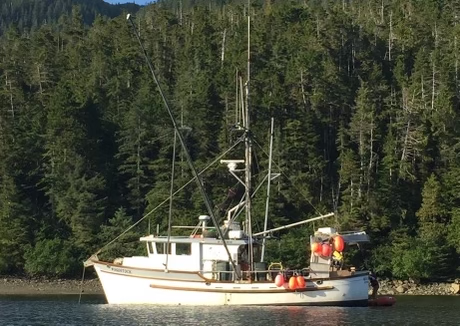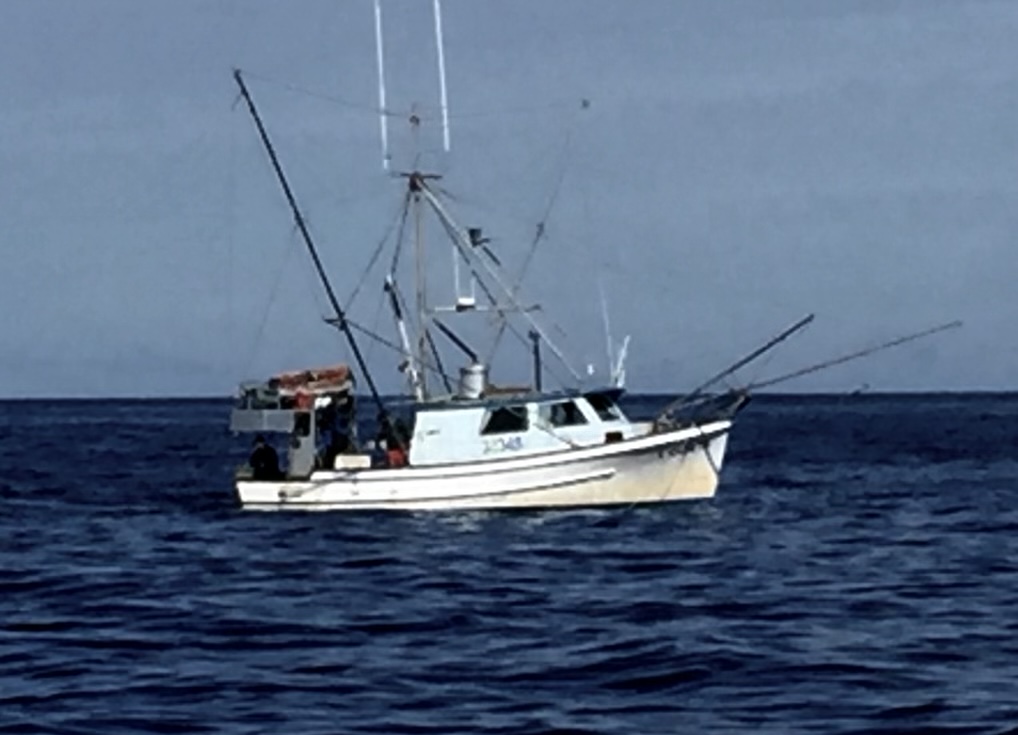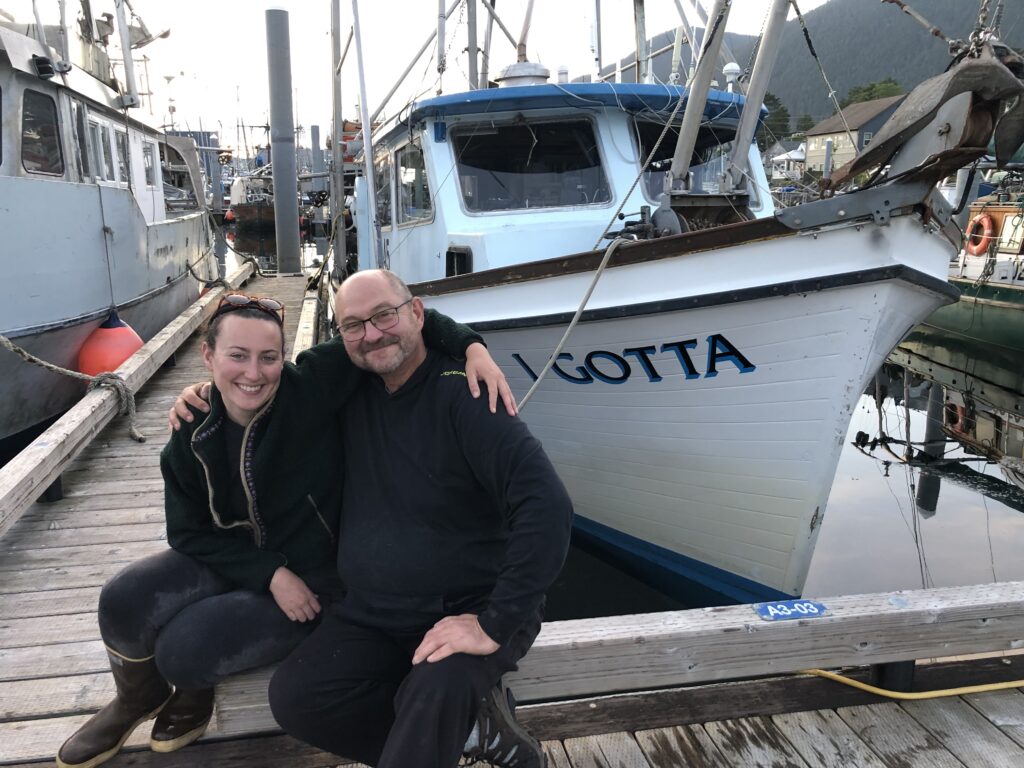EV’s, the Wave of the Future? Electric vehicles? No, electric vessels!

F/V Woodstock at sea (supplied by Kent Barkhau)
Electric cars are increasingly commonplace these days. And electric trucks – including models from Ford, GMC, and dedicated EV manufacturer Rivian – are finally rolling off the assembly line. But what about boats?
Small electrically powered boats have actually existed for over one hundred years! Larger vessels such as emissions-free commercial ferries — pioneered in Scandinavia — have been silently sailing the seas for at least 7 years now, in a variety of configurations and stages of conversion. Norway’s Yara Birkeland – the world’s first fully electric and autonomous container ship – entered service in spring of 2022.
With the critical necessity of reducing carbon emissions to net zero by 2050, this is good news. But what options exist for the commercial fishers, and the sport and pleasure mariners, who are common in Southeast Alaska?
Outboards – The Tide has Turned
Boats powered by outboard engines can make the conversion fairly easily, physically speaking. Electric outboards are currently available from a number of manufacturers, though most of them have horsepower equivalents of 5hp or less. Of the companies promoting more powerful motors (from 20hp to 80hp equivalent), Torqeedo – a German company with dealers in Alaska – and the familiar brand Mercury show up readily in internet searches.

Eric Jordan (supplied by Eric Jordan)
Mercury’s Avator 7.5e (a 3.5hp equivalent) is their only commercially available electric motor at the moment. The company does
expect to introduce a 20e and 35e later this year, and even a 300hp equivalent in the near future. Yamaha also plans to introduce a 300hp equivalent this year. Norway’s Evoy (with no US dealers yet) is set to launch their 150 hp equivalent soon, as well.
Elco Motor Yachts, a pioneer in the industry, bears special mention. They’ve been building electrically powered boats and motors since 1893! On their website, the largest outboard listed compares with a 50hp gas-fueled motor, and the site is rich with model and cost information. The “Our Story” section details their unique history.
Base costs for electric outboards (where prices are available) vary, both above and below their gas-powered counterparts. Torqeedo’s price range for 3hp-20hp equivalents runs from about $2950 to $9600, and up to $15,000 for an 80hp equivalent. Elco’s 9.9 hp equivalent lists for $2910, and their 30hp equivalent for $7000. Cost information for the Avator 7.5e couldn’t be found. While some of these numbers may seem manageable, the necessary batteries and chargers can easily double the price – discouraging many recreational boaters. Ultimately, however, the higher purchase cost is offset by lower and more stable recharging costs, minimal maintenance, zero toxic emissions and quiet operation. These lower operational costs can recoup the purchase expense quickly for heavy users.
Inboards – Headwinds Persist
Wholly electric inboard systems are increasingly available, as well as hybrid conversions, although the complexity of components packages, customization based on individual need, length of project time, and direct financial costs can still be overwhelming for recreational – and even most commercial fishing – users. Given the emerging, evolving nature of the electric vessel industry, the reader interested in up-to-date information is encouraged to contact the electric boat and/or motor company of your choice. Elco (US), Evoy (Norway), and Torqeedo (Germany), for example, will happily answer questions and even provide a quote. Torqeedo will share their cost analyses, as well. As with any new technology, the more demand, the quicker the supply of innovations and reduced costs.

F/V I Gotta at sea (supplied by Eric Jordan)
Commercial fishers in Sitka who are serious about going electric or hybrid, are – like intrepid mariners of old – still voyaging into relatively uncharted waters. Garland Kennedy, a reporter for the Daily Sitka Sentinel, has written about local ventures into the frontier of electric power on the high seas – in fact, he has done so at least twice.
In a Sentinel article in January 2020, Kennedy described how he accompanied Sitka fishing boat owner Fabian Grutter on a sea trial. Grutter had independently converted the F/V Sunbeam (his 34-foot troller/longliner) into Sitka’s first hybrid diesel-electric vessel in 2019. When questioned for this article about his impressions of his ride on the Sunbeam, Kennedy said, “Quiet!” “It was remarkably quiet, almost surreal.”
More recently, Kennedy reported on a project launched by the Alaska Longline Fishermen’s Association (ALFA) to convert two vessels – with technical expertise provided by an ETIPP grant (Energy Transitions Initiative Partnership Program) in partnership with NREL (National Renewable Energy Labs). Obviously, this technical expertise was key.
Dipping Our Toes In – Stepwise Local Approaches
One ALFA electrification project is the brainchild of Kent Barkhau and Linda Behnken, ALFA’s Executive Director. The two Sitkans have begun the conversion of their troller-longliner F/V Woodstock with the electrification of the hydraulic fishing gear aboard. With the high energy needs of conventional hydraulic systems, this makes sense as a first step, Kent says. The next step is open-ended, because of the constantly evolving technology.

Eric Jordan & Clare Wheeler (deckhand/ALFA intern 2020) by I Gotta (supplied by Eric Jordan)
In addition to electric conversions, new carbon-free hydrogen and ammonia fuels are being developed and may soon be a viable option, with a more potentially straightforward conversion process. Liquid hydrogen- fueled engines, for instance, are similar to the internal combustion engines we’re familiar with, and can be incorporated into existing supply chain and parts infrastructure more easily. Advances are also being made in hydrogen fuel cell technology and the specific power delivery system fuel cells will require.
Another beneficiary of ALFA’s ETIPP assistance is Eric Jordan, Sitka troller and lifelong Southeast Alaska fisherman. Jordan expects to have his hybrid conversion project completed next winter. As is common with hybrid systems, he’s installing a separate electric motor to power the boat, with his diesel as a back-up source. With all the considerations of matching the new motor to existing gear and shaft configurations, converting the hydraulic system, and adding additional battery banks, a lot of planning has gone into a project now entering its second year. Such challenges – along with potential costs of up to 150K (or more) for a reliable conversion – may scare off some boat owners who might otherwise be interested. Jordan’s 36’ troller, the F/V I Gotta, with its unusually spacious engine room and compact diesel engine, is serendipitously well-suited to his planned modifications. He also commonly fishes close to port so he can plug in and charge most nights. Still, why has he chosen this expensive project at this point in his long career? Because it’s important. In Jordan’s words, he loves “pioneering new technology, gear, ergonomic systems, and fisheries (and sees) reducing our carbon emissions (as) essential to sustaining fish, fisheries and humanity.”
Do the Right Thing for the Planet??
As one can tell from these electrification adventures, “doing the right thing” for the future of the planet can be a planning challenge and a significant expense. Beyond the vessels themselves, further challenges come with the shoreside charging infrastructure and the production/ source of the electricity.
Fifty-amp service is required for functional charging, and the Sitka harbor system currently has few 50- amp power pedestals. While we enjoy clean hydropower here, projected municipal growth puts us in danger of exceeding our capacity by 2030 or sooner. Predicted trends related to other beneficial electrification projects will require additional investment in renewable energy and the wisest possible use of the energy we do produce.
Beyond converting our marine fleets, the push for further electrification in order to lessen our dependence on fossil fuels – from heat pumps to electric vehicles of all types – will require a potentially lengthy, expensive, and comprehensive transition. Can we achieve this transition? We can if we make our priorities a stable clean energy future, a thoughtful conservation of existing resources, and an honest assessment of current and future energy needs.
~ by Barbara Bingham
Barbara Bingham has lived in Sitka since the early 1980s. She is retired and a member of Citizens’ Climate Lobby and Transition Sitka, two volunteer non-profit organizations focused on transitioning away from fossil fuel use. Having worked in the maritime industry for 20 years (15 of them with her own charter boats) Barb has spewed her share of carbon exhaust into the atmosphere. She welcomes the advance of clean electric power systems for vessels and vehicles alike!
Resources:
General information for this article was gleaned from the internet. Manufacturers’ websites are a good source for information about specific brands and state of the art. This is especially true of the Norwegian company, Evoy, and the US company, Elco. Plugboats.com – “everything electric boats and boating” – lives up to its motto and is another good overall resource.
Garland Kennedy
Articles:
Kennedy, G. (2022, September 27). Grant Aid Project to Fish on Kilowatts. The Daily Sitka Sentinel.
sitkasentinel.com/7/2012-05-10-22-08-10/local-news/21037-grant-aids-project-to-fish-on-kilowatts
Kennedy, G. (2020, January 2). Sitka Longliner Goes Hybrid-Electric. The Daily Sitka Sentinel.
sitkasentinel.com/7/2012-05-10-22-08-10/local-news/15904-rechargeable-boat-undergoes-sea-trial
